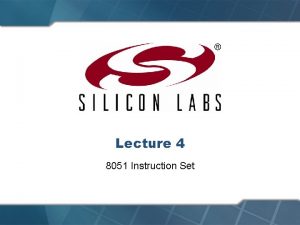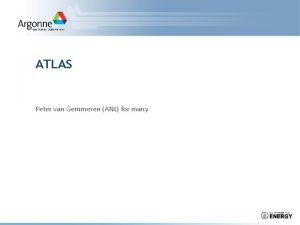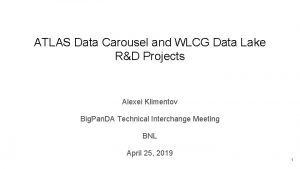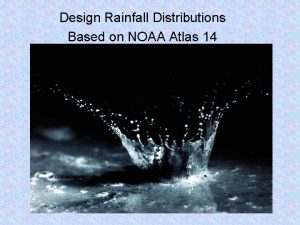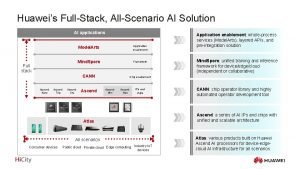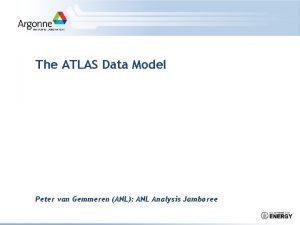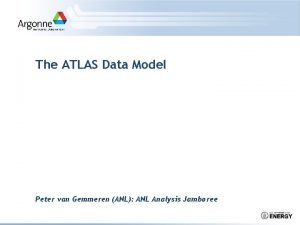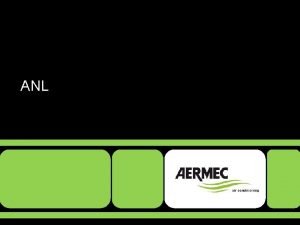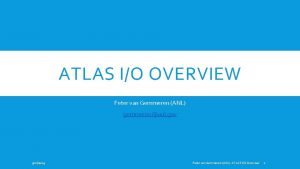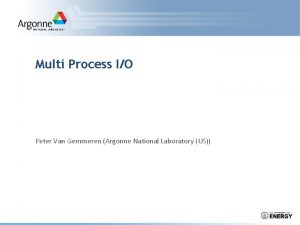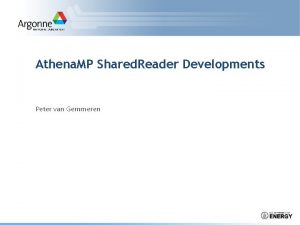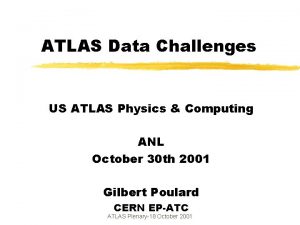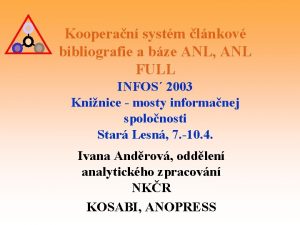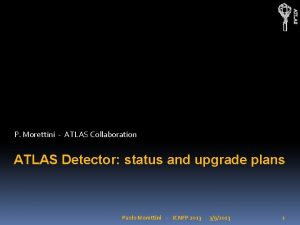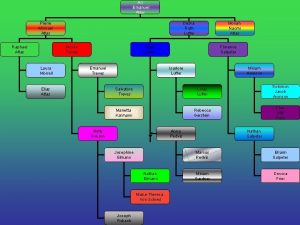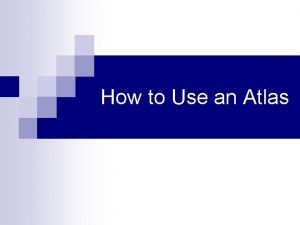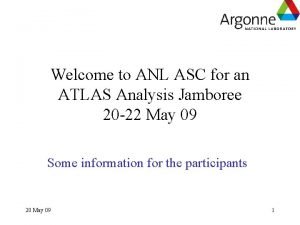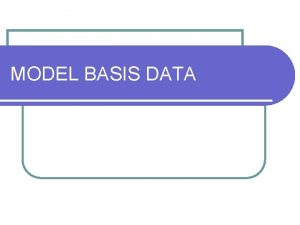The ATLAS Data Model Peter van Gemmeren ANL























![Physics. Analysis/Athena. ROOTAccess. Examples n CINT Example: lxplus: ~> root [0] TPython: : Exec("execfile('test. Physics. Analysis/Athena. ROOTAccess. Examples n CINT Example: lxplus: ~> root [0] TPython: : Exec("execfile('test.](https://slidetodoc.com/presentation_image/4730315328cd92fe8210c01865186b3d/image-24.jpg)

- Slides: 25

The ATLAS Data Model Peter van Gemmeren (ANL): ANL Analysis Jamboree

Data Flow at ATLAS RAW: n Original data at Tier-0 n Complete replica distributed among all Tier-1 ESD: n ESDs produced by primary reconstruction reside at Tier-0 and are exported to 2 Tier-1 s n Subsequent versions of ESDs, produced at Tier-1 s (each one processing its own RAW), are stored locally and replicated to another Tier-1, to have globally 2 copies on disk AOD: n Completely replicated at each Tier-1 n Partially replicated to Tier-2 s (depending on each Tier-2 size) so as to have at least a complete set in the Tier-2 s associated to each Tier-1 n Every Tier-2 specifies which datasets are most interesting for their reference community; the rest are distributed according to capacity TAG: n TAG files or databases are replicated to all Tier-1 s (Root/Oracle) n Partial replicas of the TAG will be distributed to Tier-2 as Root files n Each Tier-2 will have at least all Root files of the TAGs that correspond to the AODs stored there

Analyzing the Data n Inside Athena (RAW, RDO, ESD, AOD, DPD, TAG) – Interactive OR batch using C++, python code. – Provides full access to all tools and services. – Can submit to the grid. n Outside Athena (DPD, and to some degree ESD, AOD) – – using ROOT (to at least read) CINT, or using python, or compiled C++ code. Does not need full Athena installation (expected 1 GB) Not all classes are available (example, calo-Cells) n Important: both methods use the same files as input.

Athena/Gaudi components n All levels of processing of ATLAS data, from high-level trigger to event simulation, reconstruction and analysis, can take place within the Athena framework. n The major components of Athena are: – Services. A Service provides services needed by the Algorithms. In general these are high-level, designed to support the needs of the physicist. Examples are the message-reporting system, different persistency services, randomnumber generators, etc. – Algorithms share a common interface and provide the basic perevent processing capability of the framework. Each Algorithm performs a well-defined but configurable operation on some input data, in many cases producing some output data. – Alg. Tools. An Alg. Tool is similar to an Algorithm in that it operates on input data and can generate output data, but differs in that it can be executed multiple times per event. Each instance of a Alg. Tool is owned, either by an Algorithm, a Service, or by default by the Tool. Svc.

Common Services n There are quite a few Services in Athena to help you: – Job Option Service. The Job. Option. Svc is a catalogue of user-modifiable properties of Algorithms, Alg. Tools and Services. As an example, the value of a property called “Cut. Off" in the Jet. Maker can be set either from a joboption file or from the Athena interactive prompt by: Jet. Maker. Cut. Off = 0. 7 Default values are set in the Algorithms, Alg. Tools or Services itself. – Logging. The Message. Svc controls the output of messages sent by the developers using a Msg. Stream. The developer specifies the source of the message (its name) and the message verbosity level. The Message. Svc can be configured to filter out messages coming from certain sources or having a high verbosity level. – Performance Monitoring. The Auditor. Svc and the Chrono. Stat. Svc manage and report the results of a number of Auditor objects, providing statistics on the CPU and memory usage (including potential memory leaks) of Algorithms and Services.

And of course, Store. Gate n Store. Gate is the Athena implementation of the blackboard. n Store. Gate allows a module (such as an algorithm, service or tool) to use a data object (like for example Jet, Track or Cell) created by an upstream module or read from disk transparently. – A proxy defines and hides the cache-fault mechanism: upon request, a missing data object instance can be transparently created and added to the transient data store, retrieving it from persistent storage on demand. • On second thought I am sure you don’t want to know this. n Store. Gate allows object identification via data type and key string. – In ATLAS data objects like Jet, Track or Cell are stored in container (think STL vector, or fancy array) called Jet. Collection or Track. Collection. n Store. Gate supports base-class and derived-class retrieval, key aliases, and inter-object references. • Just say “Wow!”

Store. Gate storing Data. Objects: record() n Object (example): Missing. ET* met = new Missing. ET(); met->set. Et. Sum(arg); … Status. Code status = m_store. Gate->record(met, key /*, bool allow. Mods = true */); // check status… n Container (example): My. Jet* jet 1 = new Jet(); // create new Jet objects My. Jet* jet 2 = new Jet(); jet 1 ->set 4 Mom(arg); // setting the attributes of the Jets jet 2 ->set 4 Mom(arg); … Jet. Collection* jet. Coll = new Jet. Collection(); jet. Coll->push_back(jet 1); // pushing Jets into a container jet. Coll->push_back(jet 2); … Status. Code status = m_store. Gate->record(jet. Coll, key, false); // locked // check status…

Store. Gate storing Data. Objects: retrieve() n Object (example): // Most objects are recorded as const /*const*/ Missing. ET* met; Status. Code status = m_store. Gate->retrieve(met, key); // check status… met->set. Et. Sum(arg); // works only if not const val = met->get. Ex(); // should always be OK … n Container (example): const Track. Collection* track. Coll; Status. Code status = m_store. Gate->retrieve(track. Coll, key); // check status… for (it = track. Coll->begin(), it. End = track. Coll->end(); it != it. End; it++) { // do something with (*it), which is a Track … }

Store. Gate: Sym. Links and Aliases n Store. Gate supports base-class and derived-class retrieval via sym. Links. – e. g. : Calo. Cell is base class to Tile. Cell: status = m_store. Gate->sym. Link(t. Cell, c. Cell); status = m_store. Gate->sym. Link(Class. ID_traits<Tile. Cell>: : ID(), key, Class. ID_traits<Calo. Cell>: : ID()); – Creates symlink from Tile. Cell to its base class and allows: const Calo. Cell* b. Cell = new Calo. Cell(); // works for LAr and Tile Status. Code status = m_store. Gate->retrieve(b. Cell, key); // check status… cell. E = b. Cell->energy(); n Store. Gate supports key aliases: status = m_store. Gate->set. Alias(t. Cell, "Peters. Favorite"); Skip

Persistency: From Store. Gate to Eternity… (and back) n The only thing more exciting than finding the Higgs is writing it to disk! – Ok maybe not. Anyway, it still needs to be done. n Items in Store. Gate can be written to POOL/ROOT file using the Athena/Pool I/O infrastructure (my day job). n Existing types (like for example Jet, Track or Cell) can be written to disk by adding Output. Stream. Item. List += [ "Jet. Collection#Peters. Favorite" ]. to the job. Options file. n New types need converter and persistent state representation (somewhat harder, did I mention my email? ). n Check: Database/Athena. POOL/Athena. Pool. Example

Athena Algorithms (1): Interface n If you want to do a more complex analysis, you will want to use Athena and need to provide an algorithm. n Algorithms perform a well-defined but configurable operation on some input data and may produce output data. n Common interface provided by Gaudi: IAlgorithm n Implemented in Gaudi/Athena as Algorithm, the common base class for Algorithms. n Can use Services (e. g. , Store. Gate. Svc) and Alg. Tools via ‘Handles’. n Next slide example: Jet. Maker ->

Athena Algorithms (2): Implementation header (in src) #include "Gaudi. Kernel/Algorithm. h" #include "Gaudi. Kernel/Service. Handle. h" class Store. Gate. Svc; // Forward declaration class Jet. Maker : public Algorithm { public: /// Gaudi boilerplate /// Constructor with parameters: Jet. Maker(const std: : string& name, ISvc. Locator* p. Svc. Locator); /// Destructor: virtual ~Jet. Maker(); virtual Status. Code initialize(); virtual Status. Code finalize(); virtual Status. Code execute(); … private: /// Handle to use services e. g. , Store. Gate Service. Handle<Store. Gate. Svc> m_store. Gate; /// cut. Off (e. g. ) property, configurable by job. Options Double. Property m_cut. Off; };

Athena Algorithms (3): Implementation source #include "Jet. Maker. h" Jet. Maker: : Jet. Maker(const std: : string& name, ISvc. Locator* p. Svc. Locator) : Algorithm(name, p. Svc. Locator), m_store. Gate("Store. Gate. Svc", name) { // Property declaration (label, variable, description) declare. Property("Cut. Off", m_cut. Off, "KT Jet cut off parameter"); } Jet. Maker: : ~Jet. Maker() {} Status. Code Jet. Maker: : initialize() { // Get handle for Store. Gate. Svc and cache it: Status. Code status = m_store. Gate. retrieve(); // check status if (!status. is. Success()) { // get message service Msg. Stream log(msg. Svc(), name()); // log error message log << MSG: : ERROR << "Unable to retrieve Store. Gate. Svc" << endreq; return(Status. Code: : FAILURE); } … return(status); }

Athena Algorithms (4): Implementation source Status. Code Jet. Maker: : finalize() { Status. Code status = m_store. Gate. release(); // check status… … return(status); } Status. Code Jet. Maker: : execute() { // Do the real work once for each event const Track. Collection* track. Coll; Status. Code status = m_store. Gate->retrieve(track. Coll, key); // Let’s use those tracks to make our very own jets … Jet. Collection* jet. Coll = new Jet. Collection(); // pushing Jets into a container Status. Code status = m_store. Gate->record(jet. Coll, "Peters. Favorite"); // check status… … return(status); }

Athena Alg. Tools (1): Interface n Alg. Tools operate on input data and can generate output data, it can be executed multiple times per event. n Can be called by an Algorithm using an interface I<Alg. Tool. Name> n There can be multiple implementations of the same interface. – E. g. : an IJet. Maker. Tool could have two concrete implementation as KTJet. Maker. Tool and Cone. Jet. Maker. Tool. – Using the interface will allow the Algorithm to be configured to use either KT or Cone.

Athena Alg. Tools (2): Implementation header (in src) #include "Gaudi. Kernel/Alg. Tool. h" #include "<dir>/IJet. Helper. h" class Store. Gate. Svc; class My. Jet. Helper : virtual public IJet. Helper, public Alg. Tool { public: /// Gaudi boilerplate /// Constructor with parameters: My. Jet. Helper(const std: : string& type, const std: : string& name, const IInterface* parent); virtual ~My. Jet. Helper(); Status. Code initialize(); // called once, at start of job Status. Code finalize(); // called once, at end of job public: // Alg. Tool functionality to be implemented by all IJet. Helper virtual double help. Work(double arg) const; … private: /// Handle to use services e. g. , Store. Gate Service. Handle<Store. Gate. Svc> m_store. Gate; … }; Peter van Gemmeren Introduction to Athena and Store. Gate ANL ASC Analysis Workshop, 14 th July 2008 16

Athena Alg. Tools (3): Implementation source #include "My. Jet. Helper. h" #include "Gaudi. Kernel/ITool. Svc. h" My. Jet. Helper: : My. Jet. Helper(const std: : string& type, const std: : string& name, const IInterface* parent) : Alg. Tool(type, name, parent), m_store. Gate("Store. Gate. Svc", name) { // Property declaration // Declare IJet. Helper interface declare. Interface<IJet. Helper>(this); } My. Jet. Helper: : ~My. Jet. Helper() {} Status. Code My. Jet. Helper: : initialize() { Status. Code status = : : Alg. Tool: : initialize(); // check status… // Get handle for Store. Gate. Svc and cache it: status = m_store. Gate. retrieve(); // check status… … return(status); } Peter van Gemmeren Introduction to Athena and Store. Gate ANL ASC Analysis Workshop, 14 th July 2008 17

Athena Algorithms (4): Implementation source Status. Code My. Jet. Helper: : finalize() { Status. Code status = m_store. Gate. release(); // check status… … return(: : Alg. Tool: : finalize()); } double My. Jet. Helper: : help. Work(double arg) { // Do the real work each time called // Use m_store. Gate to retrieve/record data objects to Event. Store … return(status); } n Using Alg. Tools in Algorithms is similar to using Services: . h: Tool. Handle<IJet. Helper> m_helper; // Hold Tool. Handle. cxx, c’tor: m_helper("My. Jet. Helper"), // Init to default Alg. Tool // Allow job. Option to configure any IJet. Helper declare. Property("Helper. Tool", m_helper); Peter van Gemmeren Introduction to Athena and Store. Gate ANL ASC Analysis Workshop, 14 th July 2008 18

DPD Making OK, shifting gears Skimming, Thinning, Slimming… : Skimming is writing a subset of events n e. g. , all events containing 1 or 2 electrons within a certain eta and with a minimum p. T. n Done using TAGs. Thinning 1 (aka “poor mans’ Thinning”) is removing collections n e. g. , keep only electron container but not muons. n Here one would modify the Item. List (in the job. Options). Thinning is removing objects from a container n e. g. , keep only good electron objects. Slimming is removing quantities or sub-objects from an object n e. g. , keep only eta and p. T.

All kinds of DNPD… n Primary D 1 PD: POOL-based DPD produced by the GRID production system. There are expected to be O(10) primary DPDs, so the contents will not be very specific to an analysis. It is expected to be skimmed, slimmed, and thinned compared to the AOD. – An Example Job Options file AODto. DPD. py (see CVS) – Tau. DPDMaker – BPhysics. DPDMaker n Secondary D 2 PD: POOL-based DPD with more analysis-specific information. Typically, this is produced from Primary DPD and may be created using an Athena tool like Event. View. – Simple. Thinning. Example – High. Pt. View. DPDThinning. Tutorial n Tertiary D 3 PD: Does not need to be POOL-based, it includes flat ntuples.

Athena. ROOTAccess n Allows to read an AOD in ROOT like you would read a normal ntuple (without using Athena). – However it uses the transient classes and converters of the ATLAS software so a portion of the offline is needed. – A ~1 GB distribution including Athena libraries. – Not all Athena classes can be called from ROOT: job. Options, configurables, databases, geometry etc. are not reachable from ROOT - so athena code access has to be limited to all those classes not requiring configuration, Detector Description etc. – The user can also write Athena tools, applications that read the AOD which appears now as a ROOT tree. n One can use identical code/tools to run on ESDs, AODs, DPDs. n One can use any Analysis Framework to access the DPDs (ROOT, Athena batch, Athena interactive) n The names of the variables in the AOD ROOT tree are the same as in the AOD.

Athena. ROOTAccess Examples n CINT macros – Easy development (change code and run), – Run time is slow ~x 10 C++ compiled code n C++ compiled code – Slower development (change code, recompile, cannot reload libs) – Fastest runtime – Integrates easily back into Athena n Python scripts – Easy development (change code, reload and run) • But no help from the compiler to find bugs either! – Simple example shows runtime ~x 3 C++ compiled code • May be able to compile Python – Integration of developed code into Athena? n Examples on TWi. Ki and in Release: – https: //twiki. cern. ch/twiki/bin/view/Atlas. Protected/Athena. ROOTAccess – Physics. Analysis/Athena. ROOTAccess. Examples

Physics. Analysis/Athena. ROOTAccess. Examples n Need python script to open file and setup transient tree: lxplus: ~> get_files Athena. ROOTAccess/test. py n Compiled C++ Example: lxplus: ~> root [0] TPython: : Exec("execfile('test. py')"); root [1] Collection. Tree_trans = (TTree*)g. ROOT->Get ("Collection. Tree_trans"); root [2] Cluster. Example ce; // Example class in Athena. ROOTAccess. Examples root [3] ce. plot(Collection. Tree_trans); root [4] Truth. Info ti; root [5] ti. truth_info(Collection. Tree_trans); – The test. py script takes about ~20 seconds to load necessary dictionaries – One can recompile and then restart from the beginning
![Physics AnalysisAthena ROOTAccess Examples n CINT Example lxplus root 0 TPython Execexecfiletest Physics. Analysis/Athena. ROOTAccess. Examples n CINT Example: lxplus: ~> root [0] TPython: : Exec("execfile('test.](https://slidetodoc.com/presentation_image/4730315328cd92fe8210c01865186b3d/image-24.jpg)
Physics. Analysis/Athena. ROOTAccess. Examples n CINT Example: lxplus: ~> root [0] TPython: : Exec("execfile('test. py')"); root [1] Collection. Tree_trans = (TTree*)g. ROOT->Get ("Collection. Tree_trans"); root [2] g. ROOT->Load. Macro ("Athena. ROOTAccess. Examples/macros/cluster_example. C"); root [3] plot(Collection. Tree_trans); – One can now edit cluster_example. C and re-run Load. Macro n Python Example: lxplus: ~> python -i test. py >>> import Athena. ROOTAccess. Examples. cluster_example >>> Athena. ROOTAccess. Examples. cluster_example. plot(tt) – One can now edit cluster_example. py and re-run: >>> reload(Athena. ROOTAccess. Examples. cluster_example) >>> Athena. ROOTAccess. Examples. cluster_example. plot(tt)

Conclusion n Choose the right tool for the job (Can’t fix Tile. Cal power supplies with a chain saw or install an endcap using a microscope). n Athena is very well suited complex analyses: – Provides common Services and Tools: • Store. Gate helps you exchanging data. • Persistency allows you to easily store complex data objects (and read them back even after a possible change of the class). • Message. Svc, Auditors, Chrono. Stat. Svc, etc. help you to design efficient, robust and well performing Algorithm to do your analysis task. – Establishes Event Data Model: • Many classes for physics objects are defined for you. – Including Dictionary, Converter and persistent state representation. – Lots of functionality to help physicists develop their analysis • Can be overwhelming, so start out with the basics only. n Athena. ROOTAccess implements parts of athena’s analysis support – More light weight framework – Fast turn around
 Orl instruction in 8051
Orl instruction in 8051 Premire anl
Premire anl Anl building
Anl building Objective of greek mythology
Objective of greek mythology Noaa atlas 14
Noaa atlas 14 Atlas data lake
Atlas data lake Atlas 14 noaa
Atlas 14 noaa Nrcs atlas 14 rainfall distributions
Nrcs atlas 14 rainfall distributions James atlas model
James atlas model Ai processor
Ai processor Gambar model implementasi van meter dan van horn
Gambar model implementasi van meter dan van horn Gambar model implementasi van meter dan van horn
Gambar model implementasi van meter dan van horn Hình ảnh bộ gõ cơ thể búng tay
Hình ảnh bộ gõ cơ thể búng tay Frameset trong html5
Frameset trong html5 Bổ thể
Bổ thể Tỉ lệ cơ thể trẻ em
Tỉ lệ cơ thể trẻ em Chó sói
Chó sói Chụp phim tư thế worms-breton
Chụp phim tư thế worms-breton Alleluia hat len nguoi oi
Alleluia hat len nguoi oi Môn thể thao bắt đầu bằng từ đua
Môn thể thao bắt đầu bằng từ đua Thế nào là hệ số cao nhất
Thế nào là hệ số cao nhất Các châu lục và đại dương trên thế giới
Các châu lục và đại dương trên thế giới Công thức tính độ biến thiên đông lượng
Công thức tính độ biến thiên đông lượng Trời xanh đây là của chúng ta thể thơ
Trời xanh đây là của chúng ta thể thơ Cách giải mật thư tọa độ
Cách giải mật thư tọa độ Làm thế nào để 102-1=99
Làm thế nào để 102-1=99
